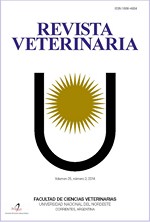Riesgos ocupacionales en estudiantes de veterinaria en Argentina
DOI:
https://doi.org/10.30972/vet.3013914Palabras clave:
Estudiantes, veterinaria, salud ocupacional, exposición, riesgosResumen
La práctica veterinaria expone a los individuos a una gran variedad de accidentes ocupacionales (AO) y enfermedades profesionales. Los objetivos de este trabajo fueron estimar: a) la frecuencia de AO y zoonosis, b) la percepción de los riesgos ocupacionales (PR), c) el uso de elementos de protección personal (EPP) y d) las asociaciones con potenciales factores de riesgo en estudiantes de veterinaria de Argentina. Se efectuó un estudio observacional transversal en n=778 estudiantes de 13 carreras de Veterinaria ubicadas en nueve provincias argentinas. Los datos fueron recolectados mediante cuestionario estructurado auto-administrado. El análisis estadístico incluyó χ2, t de Student y correlaciones de Pearson y de Spearman. Dos tercios (67,5%) había sufrido AO en la práctica con grandes y pequeños animales, con gran variabilidad entre universidades (p= 0,002). Los AO más frecuentes estuvieron vinculados con la exposición solar excesiva, los animales y los elementos punzo-cortantes. Aunque la atención clínica fue percibida como de riesgo medio o bajo, los AO se produjeron mayoritariamente en dichas instancias. Las lesiones (punzaduras, cortes, rasguños y mordeduras) estuvieron localizadas principalmente en extremidades superiores. El 6% de los estudiantes había sido diagnosticado con alguna zoonosis, siendo la dermatofitosis la más frecuente (2,8%). A mayor antigüedad como estudiante de veterinaria, mayores fueron las PR (p<0,005) y la frecuencia de AO (p<0,034). Los guantes fueron los EPP más utilizados. En algunas prácticas, su uso fue más frecuente en las mujeres (p<0,03). No hubo asociaciones entre la frecuencia de uso de EPP y las PR o los años como estudiantes de veterinaria. Se concluye que los contenidos sobre seguridad ocupacional deberían ser ofrecidos desde los primeros años de la carrera. Esta práctica, unida al esfuerzo de los docentes para que los alumnos observen el cumplimiento de prácticas seguras podrían modificar las actitudes, reduciendo los riesgos de AO y zoonosis entre los estudiantes.
Descargas
Descargas
Publicado
Cómo citar
Número
Sección
Licencia
Derechos de autor 2019 H D. Tarabla, A I. Molineri, H Robin, M L. Signorini

Esta obra está bajo una licencia internacional Creative Commons Atribución-NoComercial 4.0.
Política de acceso abierto
Esta revista proporciona un acceso abierto inmediato a su contenido, basado en el principio de que ofrecer al público un acceso libre a las investigaciones ayuda a un mayor intercambio global de conocimiento. La publicación por parte de terceros será autorizada por Revista Veterinaria toda vez que se la reconozca debidamente y en forma explícita como lugar de publicación del original.
Esta obra está bajo una licencia de Creative Commons Reconocimiento-NoComercial 4.0 Internacional (CC BY-NC 4.0)










.jpg)
.jpg)



